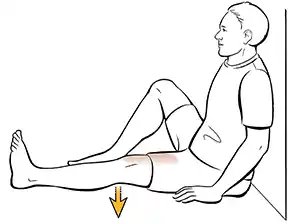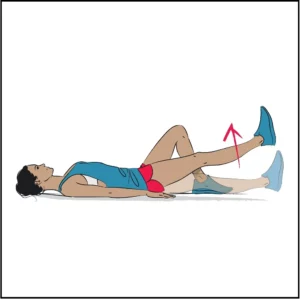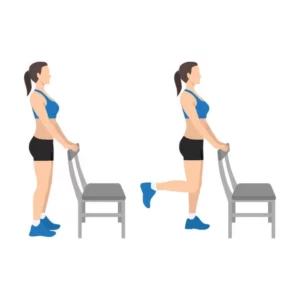If you’ve ever taken a misstep, felt an unusual twinge in your knee, or faced the sharp pang of MCL pain, you know just how incapacitating it can be. Medial Collateral Ligament (MCL) issues are not just reserved for elite athletes; they can sideline anyone. But the good news? You’re not alone, and more importantly, you’re not without solutions. From simple exercises that can be done in the comfort of your living room to cutting-edge treatments, relief is closer than you think. Dive in as we unravel the mysteries of Medial Collateral Ligament pain and arm you with the tools you need to bounce back stronger and pain-free.
Contents
What is the Medial Collateral Ligament (MCL)?
 The Medial Collateral Ligament, commonly referred to as the MCL, is one of the four primary ligaments located in the knee. Situated on the inner side of the knee joint, it connects the thigh bone (femur) to the shinbone (tibia). Its main role? Stabilizing the knee and preventing it from bending inward.
The Medial Collateral Ligament, commonly referred to as the MCL, is one of the four primary ligaments located in the knee. Situated on the inner side of the knee joint, it connects the thigh bone (femur) to the shinbone (tibia). Its main role? Stabilizing the knee and preventing it from bending inward.
Acting as a vital support structure, the MCL resists excessive inward rotation and sideward motion of the knee, ensuring our legs move in a coordinated and safe manner. Whether you’re walking, running, or jumping, the MCL is working behind the scenes, ensuring your knee remains stable and aligned. However, like any part of our body, it’s susceptible to injury, especially when subjected to sudden twists or direct impacts.
Common Causes of MCL Pain
 The Medial Collateral Ligament (MCL) is a robust structure, but it’s not immune to injury. When it comes to MCL pain, there are several culprits that can be pinpointed as its origin:
The Medial Collateral Ligament (MCL) is a robust structure, but it’s not immune to injury. When it comes to MCL pain, there are several culprits that can be pinpointed as its origin:
- Sports-Related Incidents: Athletes, especially those involved in contact sports like football, soccer, and rugby, are particularly susceptible. A sudden blow to the outer knee, a swift change in direction, or an awkward landing can all strain or tear the MCL.
- Accidents and Falls: Slipping on ice, taking a wrong step, or even minor accidents like bumping your knee against a hard surface can lead to MCL pain. Such incidents can cause the knee to twist or bend in a way it’s not supposed to.
- Wear and Tear: Just like any other part of our body, the MCL can degrade over time. Regular wear and tear, especially in older individuals or those engaged in heavy physical activity, can weaken the ligament, making it more prone to injury.
- Improper Footwear: Surprisingly, the shoes you wear can influence your MCL’s health. Footwear that doesn’t provide adequate support can lead to misalignment of the leg, putting unnecessary strain on the MCL.
- Overuse: Repeatedly engaging in activities that put stress on the MCL without allowing it adequate time to heal can result in chronic pain or more severe injuries.
Understanding these common causes is the first step toward prevention and proper treatment. By being aware and taking precautionary measures, it’s possible to significantly reduce the risk of MCL injuries.
Grading MCL Injuries: From Mild to Severe
When it comes to MCL injuries, they’re not all created equal. Just like many ligament injuries, MCL strains and tears are typically categorized into three primary grades, each representing a different severity level. Here’s a breakdown:
- Grade I (Mild):
- Description: This is the mildest form of MCL injury, characterized by slight stretching or minor tearing of the ligament fibers.
- Symptoms: Individuals might experience tenderness and some pain on the inner knee. However, the knee remains mostly stable, and there is minimal swelling.
- Implications: While painful, Grade I injuries often heal on their own with proper rest, ice, compression, and elevation (RICE method). Over-the-counter pain relievers can also provide relief.
- Grade II (Moderate):
- Description: A Grade II injury means the MCL has been partially torn but is not completely severed.
- Symptoms: There’s noticeable pain, tenderness, and moderate swelling around the area. The knee might feel unstable or give out during certain movements.
- Implications: This type of injury often requires more intensive care, such as immobilization with a brace and physical therapy. Recovery time tends to be longer than Grade I injuries but doesn’t always require surgical intervention.
- Grade III (Severe):
- Description: In this most severe classification, the MCL is completely torn apart.
- Symptoms: Severe pain, swelling, and bruising are common. The knee will feel very unstable, and it might be challenging to bear weight on it.
- Implications: Grade III injuries frequently necessitate surgical repair, especially if other parts of the knee are injured concurrently. A comprehensive rehabilitation program post-surgery is crucial for regaining strength and mobility.
Understanding the grading of an MCL injury is vital, not just for gauging its severity but also for tailoring the right treatment approach.
Conservative & Surgical Treatment Options To Treat Medial Collateral Ligament Pain
When faced with Medial Collateral Ligament pain, the path to recovery can vary widely based on the injury’s severity and individual circumstances. The spectrum of treatment options falls broadly into two categories: conservative (non-surgical) and surgical. Let’s break down both:
Conservative Treatment Options

- Rest: One of the initial and most crucial steps in healing is allowing the injured knee some downtime. It helps to minimize further damage and provides the body with an opportunity to initiate the healing process.
- Ice: Applying ice to the affected area can help reduce swelling and numb the area, diminishing pain. Ensure the ice is wrapped in a cloth to avoid frostbite.
- Compression: Wearing a knee brace or bandage can provide support and limit swelling. It also helps stabilize the knee, preventing further injury.
- Elevation: Keeping the knee elevated helps reduce swelling by draining excess fluid. This also aids in pain relief.
- Physical Therapy: For Grade I and some Grade II injuries, physical therapy can be extremely beneficial. A therapist will guide the patient through exercises and stretches that promote healing and strengthen the knee to prevent future injuries.
- Medications: Over-the-counter pain relievers and anti-inflammatory drugs can help manage pain and reduce swelling.
Surgical Treatment Options
 While conservative treatments work well for mild to moderate MCL injuries, severe injuries, particularly Grade III tears, might require surgical intervention.
While conservative treatments work well for mild to moderate MCL injuries, severe injuries, particularly Grade III tears, might require surgical intervention.
- MCL Repair: In cases where the ligament is torn but the ends are still close together, surgeons might stitch the torn ends back together.
- MCL Reconstruction: If the MCL is torn to an extent where stitching it back is not feasible, surgeons might opt to replace the damaged ligament with a tissue graft. This graft could be taken from another part of the patient’s body or a donor.
- Post-Surgery Rehabilitation: After surgery, an extensive rehabilitation program is essential. Physical therapy sessions will focus on regaining strength, flexibility, and mobility in the knee.
In choosing between conservative and surgical treatments, the decision should be made in consultation with a medical professional. They will consider the injury’s grade, the patient’s age, activity level, and other individual factors to determine the best course of action.
Rehabilitation and Physical Therapy Techniques
Rehabilitation plays a pivotal role in recovering from an MCL injury. Physical therapy helps restore knee function, improves flexibility, and strengthens the muscles around the knee to prevent future injuries. Here are some essential exercises and stretches specifically tailored for MCL rehabilitation:
Quad Sets

- Sit with your legs extended in front of you.
- Tighten the quadriceps (front thigh muscle) by pushing the back of your knee down towards the ground.
- Hold for 5-10 seconds, then release.
- Repeat 10-15 times for 2-3 sets.
Heel Slides
- Lie on your back with your legs extended.
- Slowly bend one knee by sliding your heel towards your buttocks.
- Slide back to the starting position.
- Repeat 10-15 times for each leg, and aim for 2-3 sets.
Straight Leg Raises

- Lie on your back with one leg bent at the knee and the other straight.
- Tighten the quadriceps of the straight leg and lift it to the height of the bent knee.
- Slowly lower the leg back down.
- Do 10-15 repetitions for each leg, spanning 2-3 sets.
Hip Abduction
- Lie on your side with the injured knee facing upwards.
- Keeping your leg straight, lift it towards the ceiling.
- Slowly lower back down.
- Execute 10-15 repetitions for each leg, completing 2-3 sets.
Hamstring Curls

- Stand behind a chair for support.
- Bend one knee, bringing your heel towards your buttocks.
- Slowly lower the leg back down.
- Perform 10-15 repetitions for each leg over 2-3 sets.
Terminal Knee Extension
- Using a resistance band anchored at ankle height, step into the loop with the injured leg.
- Stand with a slight bend in the injured knee.
- Straighten the knee against the resistance, then slowly return to the starting position.
- Aim for 10-15 repetitions, doing 2-3 sets.
Physical therapy techniques should be personalized to match the individual’s pain level, injury severity, and recovery stage. It’s essential to consult with a licensed physical therapist who can guide you through these exercises, ensuring they are executed correctly and safely.
Conclusion
Medial Collateral Ligament (MCL) pain can be a daunting challenge, especially for individuals leading active lifestyles. Rehabilitation and physical therapy are invaluable tools in the journey to recovery, ensuring not just healing but also strengthening the knee against potential future injuries. If knee pain is affecting your day-to-day activities, remember that you’re not alone. At PhysioMantra, we specialize in knee pain rehabilitation, offering tailored physical therapy for knee pain to suit your unique needs. Don’t let pain hold you back any longer. Book an online physical therapy session with us today and take the first step towards a pain-free life.



